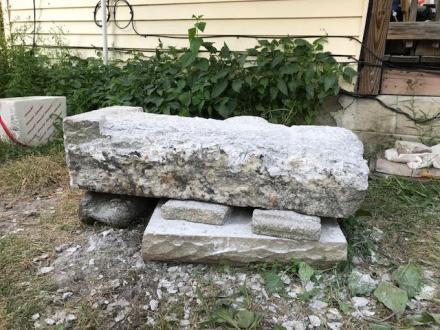
Master carver Buddha Subba, long associated with Refugee Artisans of Worcester, relishes working with sandstone of the sort he was familiar with back in Bhutan in his Nepali-speaking community there. Sandstone’s relative softness and granularity makes it easier to cut and shape than granite or marble (though Buddha has also done some carving of both those famous harder, denser stones in Massachusetts). He once told the RAW co-directors that he wished he had ready access to the sort of sandstone blocks used to construct an old railway station in one of the small towns outside Worcester. But no, central Massachusetts is not Asia and Buddha has been making his remarkable sculptures of divine beings of late with the stone types available here, with only some small access to sandstone.
In a cooperative relationship for several years with a local stonemasonry firm (Camosse Masonry Supply) Buddha lent his talents to that business and in return got studio space there. Some of his sacred sculptures won prizes in a major competition sponsored by a Worcester Buddhist temple (Boundless Way, on Pleasant Street). Other sculptures he has made live in city residents’ homes and back yards, via sales through RAW. The varieties of natural stone Buddha has been working with are described below.
Sandstone
Sandstone is a sedimentary rock composed mostly of tightly compacted sand. It can be worked into sculptures or ornate relief carvings fairly easily by first shaping a large block of the stone with a hammer and then removing smaller bits by abrasion techniques. Metal chisels help with the fine details. Many of the great Buddhist and Hindu temples and temple sculptures of India, wider South Asia, and Southeast Asia were carved from sandstone.
Granite
Granite is the hardest stone used for carving. In fact, simple hammer and chisel techniques will not work with granite. Steam-powered steel tools invented in the 1830s represented a major technological breakthrough for working this beautiful stone. Granite derives from magma and contains a high content of silica and metal oxides (yielding granite’s wide and lovely color range). Granite in large blocks is often used in building construction, as it is tough, hard, durable, and gorgeous.
Marble
Marble is another hard stone of great beauty but is somewhat more easily worked than is granite. Limestone is marble’s geological parent. Marble is remarkably weather resistant. It is durable if not exposed to acid or acid rain. Marble is mined from large quarries, such as Carrara in northern Italy. Marble can be polished and it has a translucent quality that makes it ideal for representing human skin in sculptures.